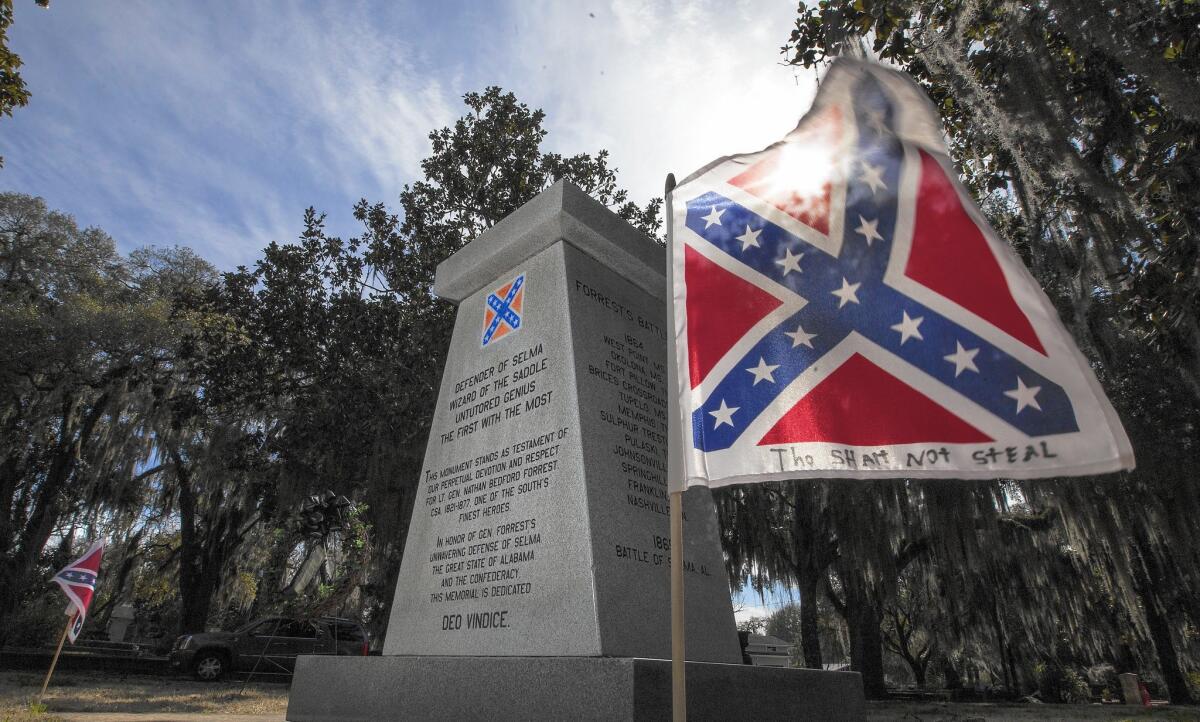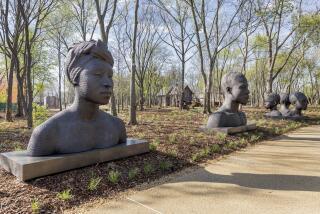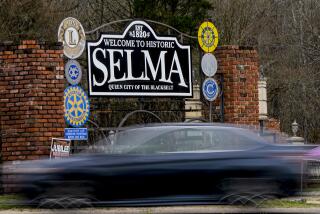Selma, 50 years after march, remains a city divided

In preparation for the weekend’s goings-on, Selma city workers put up barricades downtown, outside Carter Drug.
In the 1960s, the drugstore served as a catalyst for the civil rights movement because its soda counter would not serve black customers. As the workers set up metal railings for crowd control, a white-haired former city councilman, Glenn Sexton, stepped from the drugstore and surveyed the scene from the sidewalk.
The outside world — presidents, civil rights legends, celebrities and tens of thousands of visitors — would arrive shortly to remember the civil rights marchers who were tear-gassed and beaten 50 years ago this weekend, by club-wielding officers on the Edmund Pettus Bridge, just to Sexton’s right.
In 2000, during his time on the City Council, Sexton and two other council members used city funds to help pay for a statue of Nathan Bedford Forrest, a Confederate general and the first grand wizard of the Ku Klux Klan.
“It’s going to be nothing but a nigger street party,” Sexton said, using an epithet still heard on the streets here. He went on to describe participants in the march — both the one in 1965 and a reenactment this Sunday — with a torrent of vulgarities.
Selma today is a strange and complex place, difficult for even other native Alabamans to understand; a white passerby overhearing Sexton’s rant dropped his head and walked on. Half a century after the civil rights movement made it famous, the city’s extremes have become entrenched, as separate and unmoving as the banks of the Alabama River that runs through its heart.
And while people on the extremes stay at war, the majority in this city of about 20,000 residents are suffering. Dallas County ranked as the poorest in the state last year, with unemployment at 10.2%. Forty percent of families in Selma live below the poverty line, and violent crime is five times that in other towns around Alabama.
The town’s infrastructure is crumbling, literally. Workers tried this week to paint and cover broken-down buildings, but the blight is pervasive. The house once owned by now-centenarian activist Amelia Boynton Robinson — the place where organizers planned the original march — is boarded up.
White residents have fled the city. Selma, evenly divided in 1965, is now 80% black, and housing projects crop up where cotton mills once sat. Selma’s white residents live in an ever-shrinking quarter where antique churches are immaculately preserved and Spanish moss drapes from magnolia trees.
A group of Selma residents calling themselves the Friends of Forrest has erected a billboard welcoming visitors to town, ahead of the civil rights jubilee. The sign at the foot of the Edmund Pettus Bridge, on the route President Obama’s motorcade will probably take from Montgomery, features Forrest on horseback, with a quote urging his men to frighten their foes: “Keep the skeer on ‘em.”
Forrest’s most passionate friend in Selma is Pat Godwin, known here as the Wizardess, who calls the 1965 voting rights march “the mother of all orgies,” and tells telephone callers in a chipper voice, “We can’t take your call right now, there’s a war going on!”
Her most vociferous opponent is Rose Sanders, a Harvard-educated lawyer who has waged civil rights cases and who, some residents here say, has made a cottage industry of Selma’s division.
“Some people have a need to not be satisfied,” said Jamie Wallace, who in 1965 was an editor at the Selma Times-Journal. He stood on the Edmund Pettus Bridge with civil right marchers when they were attacked on Bloody Sunday. He and other newspaper staffers resisted enormous pressure from advertisers, subscribers and the Selma elite to ignore the Rev. Martin Luther King Jr. and the marchers. This weekend, he will be presented a Living Legend Award by Selma’s mayor, a black man.
Things were bad in 1965, Wallace said. They are still bad. “But I dispute anyone who claims we didn’t change anything,” he said. “We went from an all-white power structure to all black. That means something.”
Sanders is an organizing force behind this weekend’s 50th anniversary celebration. In a back room of the jubilee’s headquarters this week, she railed at the White House for not being involved enough.
Referring to how detractors would view the city, she said: “A black president in a black city. They are going to take every opportunity to make us look stupid.”
The Rev. Jesse Jackson sat nearby on a wicker sofa, watching Sanders and her volunteers work.
“People coming to Selma in a celebration mood should be in a protest mood,” he said.
Sanders agreed. “Sixty percent of Selma’s children live in poverty,” she told him.
Jackson nodded. “People assume there is a correlation between political power and economic power,” he said. But a black power structure — mayor, city council, police force — is not enough.
“You change the political power, and the white business owners just move outside the city. So you have power over a doughnut hole. We need help to climb out of the doughnut hole,” he said.
He went on to describe a plan in which the government would intervene to stop people from relocating their businesses. “It’s the only way,” Jackson said.
Sanders said the problem was deeper. It’s cultural. “People forget that even the Jews wanted to integrate into their society. That’s why so many of them were killed before they realized what was going on,” she said. “It’s not unique to black people. When you see powerful people, it’s a natural inclination to want to integrate with those people.”
But wasn’t that why King and so many Selma residents marched? For integration?
“No, no,” she said. “I’m saying we need to do what the Jews have learned to do: maintain your identity.”
The acrimony between white and black Selma is neatly captured at the monument Sexton helped erect to Forrest, which describes him as “defender of Selma, wizard of the saddle, untutored genius, the first with the most.” A bronze bust of Forrest sat on top of the monument until someone stole it a few years ago.
The Friends of Forrest said Sanders was behind the theft. She accused them of staging a fake theft to win sympathy.
Now beside the monument there sits a funereal wreath, decorated with black lace and pearls, and bearing a laminated letter by Godwin titled: “Retraction of Reference to Rose Sanders as a ‘Domestic Terrorist’ in the Previous Essay Titled ‘The Day Justice Died In Alabama,’ to the Extent that the Use of Said Term May Be Perceived as Having Implied Commission of Any Unlawful Activity or the Commission of Any Criminal Offense By Rose Sanders.”
The letter carries on from there. The dispute over Nathan Bedford Forrest’s missing head has lasted longer than the Civil War itself.
On Friday, Godwin visited the site, where she and her supporters sometimes spend the night to defend the monument.
“She thinks she has defeated me and Gen. Forrest,” she said of Sanders. “She has not!”
At City Hall, Mayor George Evans sunk slightly into his chair when asked about the continued division. Of racists, he shook his head and said, “There will always be people who find it hard to change.”
Sexton was sworn in as a councilman in 2000, the year Selma elected its first black mayor.
Sexton represented Ward 1, which makes up the city’s white quarter, and as he took the oath a crowd started to boo. Evans, council president at the time, had to shush the crowd.
Most people in Selma don’t support thinkers on either edge of society, Evans said this week. “The majority of folks in Selma want to get along and work together.”
Selma’s founders called it the Queen City of the Black Belt, and the name itself means “throne,” taken from “Songs of Selma” by 18th century Scottish poet James Macpherson. What remains of that throne, now, is at Selma Country Club, across the street from the spot where Nathan Bedford Forrest’s bronze head disappeared.
Christina Siddens, general manager of the club, balked recently when asked whether it has a whites-only policy.
“No, that’s not exactly true,” she said. “We don’t.... I mean. Look, I just sort of work here.”
So Selma Country Club has black members?
“No,” she said. “We don’t.”
Twitter: @MatthewTeague
More to Read
Start your day right
Sign up for Essential California for news, features and recommendations from the L.A. Times and beyond in your inbox six days a week.
You may occasionally receive promotional content from the Los Angeles Times.






